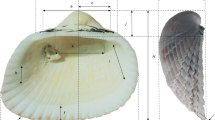Abstract
A study of the distribution of the prism width inside the prismatic layer of Unio tumidus (Philipsson 1788, Diss Hist-Nat, Berling, Lundæ) from Lake Neuchâtel, Switzerland, has been conducted in order to determine whether or not this distribution is random. Measurements of 954 to 1,343 prism widths (depending on shell sample) have been made using a scanning electron microscope in backscattered electron mode. A white noise test has been applied to the distribution of prism sizes (i.e. width). It shows that there is no temporal cycle that could potentially influence their formation and growth. These results suggest that prism widths are randomly distributed, and related neither to external rings nor to environmental constraints.
Similar content being viewed by others
References
Bargetzi JP (1960) Application de méthodes d’analyse biochimique à un problème taxonomique: les Corégonés du lac de Neuchâtel. Ph.D. thesis, Université de Neuchâtel
Checa A (2000) A new model for periostracum and shell formation in Unionidae (Bivalvia, Mollusca). Tissue Cell 32:405–416
Checa AG, Rodriguez-Navarro A (2001) Geometrical and crystallographic constraints determine the self-organization of shell microstructures in Unionidae (Bivalvia: Mollusca). Proc R Soc Lond 268:771–778
Checa AG, Rodriguez-Navarro A, Esteban-Delgado FJ (2005) The nature and formation of calcitic columnar prismatic shell layers in pteriomorphian bivalves. Biomaterials 26:6404–6414
Clark GR II (1975) Periodic growth and biological rhythms in experimentally grown bivalves. In: Rosenberg GD, Runcorn SK (eds) Growth rhythms and the history of the earth’s rotation. Wiley, London, pp 103–117
Dunca E, Mutvei H (2001) Comparison of microgrowth pattern in Margaritifera margaritifera shells from south and north Sweden. Am Malacol Bull 16:239–250
Goodwin DH, Flessa KW, Schöne BR, Dettman DL (2001) Cross-calibration of daily growth increments, stable isotope variation, and temperature in the gulf of California bivalve mollusk Chione cortezi: implications for paleoenvironmental analysis. Palaios 16:387–398
Hall CA Jr (1975) Latitudinal variation in shell growth patterns of bivalve molluscs: implications and problems. In: Rosenberg GD, Runcorn SK (eds) Growth rhythms and the history of the earth’s rotation. Wiley, London, pp 163–175
Lonne OJ, Gray JS (1988) Microgrowth bands in Cerastoderma edule. Mar Ecol Prog Ser 42:1–7
Martoja M (1995) Mollusques. Collection synthèses. Oceanographic Institute, Paris
Mutvei H, Westermark T (2001) How environmental information can be obtained from Naiad shells. In: Bauer G, Wächler K (eds) Ecology and evolution of the freshwater mussels Unionida. Ecological studies, vol 145. Springer, Berlin Heidelberg New York, pp 367–379
Philipsson LM (1788) Dissertatio historico-naturalis sistens nova testaceorum genera. Quam præside D.M. Andr. J. Retzio (…) ad publicum examen defert Laurentius Münter Philipsson. Dissertatio Historico-Naturalis, Berling, Lundæ
Rhoads DC, Lutz RA (1980) Skeletal growth of aquatic organisms. Biological records of environmental change. Plenum, New York
Richardson CA (1987a) Microgrowth patterns in the shell of the Malaysian cockle Anadara granosa (L.) and their use in age determination. J Exp Mar Biol Ecol 111:77–98
Richardson CA (1987b) Tidal bands in the shell of the clam Tapes philippinarum (Adams and Reeve, 1850). Proc R Soc Lond B 230:367–387
Richardson CA (1990) Tidal rhythms in the shell secretion of living bivalves. In: Brosche P, Sundermann J (eds) Earth’s rotation from eons to days. Springer, Berlin Heidelberg New York, pp 215–226
Richardson CA (1996) Exogenous or endogenous control of growth band formation in subtidal bivalve shells? Bull Inst Océanogr Monaco 14:133–141
Richardson CA, Crisp DJ, Runham NW (1980a) An endogenous rhythm in shell deposition. J Mar Biol Assoc UK 60:991–1004
Richardson CA, Crisp DJ, Runham NW (1980b) Factors influencing shell growth in Cerastoderma edule. Proc R Soc Lond B 210:513–531
Richardson CA, Crisp DJ, Runham NW, Gruffydd L1D (1980c) The use of tidal growth bands in the shell of Cerastoderma edule to measure seasonal growth rates under cool temperature and sub-artic conditions. J Mar Biol Assoc UK 60:977–989
Toubin M, Dumont C, Verrecchia EP, Laligant O, Diou A, Truchetet F, Abidi MA (1999) Multi-scale analysis of shell growth increments using wavelet transform. Comp Geosci 25:877–885
Turner H, Kuiper JGJ, Thew N, Bernasconi R, Ruetschi J, Wuthrich M, Gosteli M (1998) Fauna Helvetica 2: Atlas der Mollusken der Schweiz und Liechtensteins. Centre Suisse de Cartographie de la Faune, Neuchâtel
Verrecchia EP (2004) Multiresolution analysis of shell growth increments to detect natural cycles. In: Francus P (ed) Image analysis, sediments and paleoenvironments. Developments in paleoenvironmental research, vol 7. Kluwer, Dordrecht, pp 273–293
Whyte MA (1975) Time, tide and the cockle. In: Rosenberg GD, Runcorn SK (eds) Growth rhythms and the history of the earth’s rotation. Wiley, London, pp 177–189
Author information
Authors and Affiliations
Corresponding author
Rights and permissions
About this article
Cite this article
Vancolen, S., Verrecchia, E. Does prism width from the shell prismatic layer have a random distribution?. Geo-Mar Lett 28, 383–393 (2008). https://doi.org/10.1007/s00367-008-0115-5
Received:
Accepted:
Published:
Issue Date:
DOI: https://doi.org/10.1007/s00367-008-0115-5




